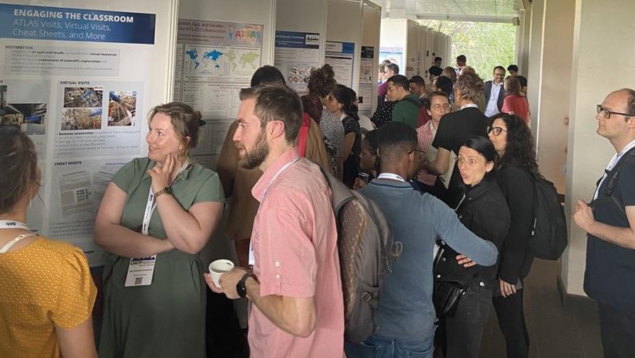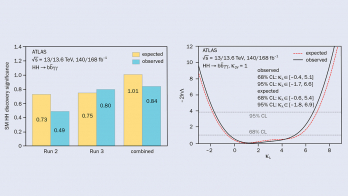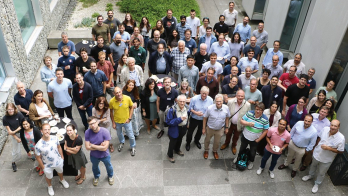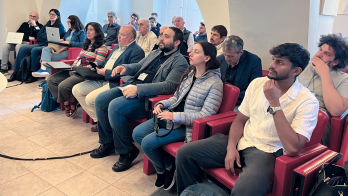
About 350 physicists attended the 11th edition of the Large Hadron Collider Physics (LHCP) conference in Belgrade, Serbia from 22 to 26 May. The first-in person edition since 2019, the conference triggered productive discussions between experimentalists and theorists across the full LHC physics programme. It also addressed the latest progress of the High-Luminosity LHC upgrades and future-collider developments, in addition to outreach, diversity and education. The conference took place in parallel with the successful restart of LHC Run 3, and saw about 40 new results released for the first time.
The initial physics results from the Run 3 dataset collected in 2022 by ATLAS and CMS were shown, featuring the first measurement of the Higgs-boson production cross-section by ATLAS at 13.6 TeV. Clearly the Run 2 dataset is still a gold mine for the LHC experiments. The programme of precision measurements of Higgs-boson properties is continuing with improved accuracy from the full Run 2 dataset. In particular, ATLAS and CMS reported a new combined result targeting the rare decay H → Zγ, for which they found evidence at the level of 3.4σ and a measured rate slightly higher but comparable to that predicted by the Standard Model.
Innovative signatures
Searches for physics beyond the Standard Model (SM) remains a very active field of research at the LHC, with many innovative signatures explored, including those of long-lived particles. Some of these searches use new anomaly-detection techniques and explore potential lower-production cross sections. A new search of leptoquarks by CMS exploiting the leptonic tau content of the proton was reported, while ATLAS reported a search for stau production in supersymmetry models with much improved sensitivity. Many other searches were also presented, and while a few low-level excesses exist, more data will be required to check if these are statistical fluctuations or not.
The SM is under intense scrutiny but is still very successful at the high-energy frontier. A recent re-analysis of the W-boson mass by ATLAS with the 7 TeV dataset shows good agreement with SM predictions, unlike the CDF result released in 2022. Validating the model used for the ATLAS W-mass measurement, new precise measurements of the W and Z bosons’ transverse momentum distributions were reported by ATLAS using Run 2 data collected under lower pileup conditions. Vector-boson scattering processes are an important probe of the electroweak symmetry breaking mechanism, and most such processes are now observed at the LHC.
Exploring the top-quark sector, many recent results focused on rare top-production processes. Four-top production was observed recently by ATLAS and CMS. First evidence for the rare tWZ production mode was shown by CMS at LHCP 2023. Some of these rare production modes are seen with rates somewhat higher than predicted, and more data will be required to conclude if the differences are significant. Top production is also used to investigate more exotic scenarios. A new CMS result, measuring the tt– production cross section as a function of sidereal time, was reported. No indication of Lorentz invariance violation is observed.
Presentations covered the broad spectrum of physics at the LHC brilliantly
On the flavour-physics side, LHCb reported a new precise measurement of CP violation in the “golden” B → J/ψ Ks decay, with the most precise extraction of the beta angle of the CKM quark-mixing matrix (see p16). Recent LHCb results on the flavour “anomalies” no longer show an indication for lepton universality violation in B → Ke+e– compared to B → Kμ+μ– decay rates, but some puzzles remain and there is still some tension in the tau-to-muon ratio in the tree-level decays B → B(*)τ(µ)ν. Lepton-flavour violation is investigated in a new CMS result searching for the forbidden τ → 3µ decays, where an upper limit close to the Belle result was reported.
Characterisation of the quark–gluon plasma is actively studied using PbPb collision data. New results from ALICE regarding investigations of jet-quenching properties as well as charm fragmentation studies were shown at the conference.
The recent detections of collider-produced neutrinos by the new FASER and SND experiments were also presented, marking the start of a new physics programme at the LHC.
Broad spectrum
Several theory presentations highlighted recent progress in SM predictions for a wide range of processes including the electroweak sector, top-quark and Higgs-boson productions, as well as linking LHC physics to lattice QCD computations – work that is vital to fully exploit the physics potential of the LHC. Open questions in the various sectors were summarised and prospects for new-physics searches in Run 3, including those related to the Higgs-boson sector, were discussed. Links between LHC physics and dark matter were also highlighted, with examples of light dark-matter models and feebly interacting particles. Effective field theories, which are key tools to probe new physics in a generic way, were described with emphasis on the complementarity with searches targeting specific models.
Overall, the presentations covered the broad spectrum of physics at the LHC brilliantly. Future data, including from the High-Luminosity LHC phase, should allow physicists to continue to address many of the field’s open questions. Next year’s LHCP conference will be held at Northeastern University in Boston.







